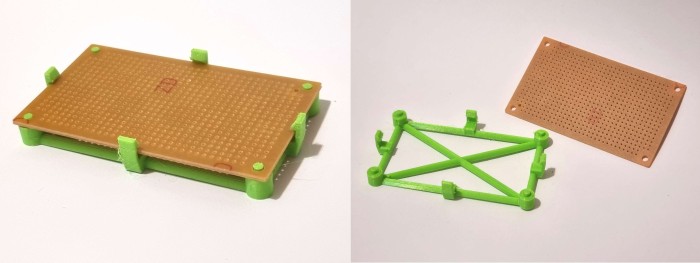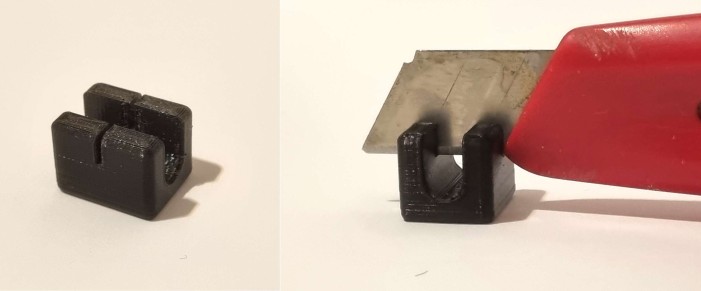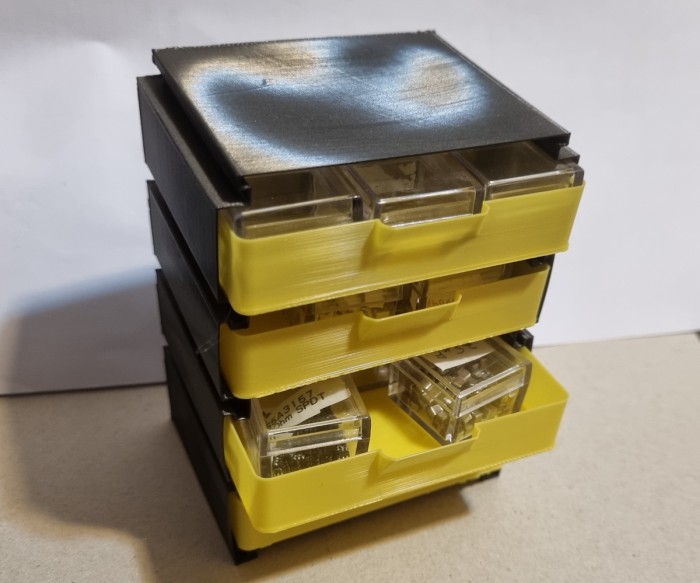3D printing for embedded development
Used mostly for creating little plastic objects, the desktop 3D printer is not an obvious addition to the embedded developer's toolbox. However, if you're looking for more reasons to get one, or already have one that's mostly gathering dust, here are a couple of embedded-related ways to get more value out of it.

Lens salvaged from an old camera; handle designed and 3D-printed at home.
The Fine Print
First, a warning: There are lots of neglected 3D printers out there. Too many people buy them thinking that from now on, they'll just print everything they need around the house; But it doesn't work that way. The process is a lot more involved, demanding, and limited. So, before we talk about benefits, here's a list of the obstacles you should expect after getting your first 3D printer (based in part on my own experience):
- Maintenance: Even the modern or expensive 3D printers need the occasional calibration, tightening of a screw or a belt, replacing of a nozzle etc. It's not too difficult and there are plenty of instructional guides and videos, but it has to be done.
- Design: Relying only on models downloaded from the web will not get you far. The real value of a home 3D printer comes from designing objects yourself, and that means mastering a 3D design tool/program. It doesn't really matter which – for example, I'm using the kid-oriented Tinkercad and it's fine for my needs.
- Slicing: To turn that perfect, virtual 3D model into reality you'll have to "slice" it first, i.e. run it through a program that generates the command sequence file for the printer. These slicing programs have tons of parameters to set or tweak, and in order to get good prints, you'll have to familiarize yourself and experiment with at least some of them.
- Plastic and structure: If printing materials were electronic components, they'd have worse errata than [enter your least favorite vendor here]: combined with the limitations of the printer itself, the printed objects are never as durable or accurate as what you'd get from an industrial process. There are some workarounds and tricks of the trade that you can learn, though, to alleviate this problem per specific requirements.
With all these terrible things in mind, why would anyone still want a 3D printer? Let's demonstrate…
Case Study Caddy
A client of mine had a motorized thingamajig that moved on tracks, and he wanted to add a few sensors to it, to detect and measure stuff along the path. The electronics and firmware for the sensors were simple, but the sensors also needed some kind of physical platform, or a caddy, to attach them mechanically to the device and hold them in the right position as it moved. We didn't know the optimal angles and distances for the sensors, it was a matter of trial and error.
Of course, embedded developers are not necessarily mechanical engineers, and I wouldn't suggest anyone to leave the final design of a mechanical part to the Tinkercad skills of an amateur. Nonetheless, with my humble knowledge and printer I was able to design raw caddy prototypes, tweak them, and churn them out almost as fast as the client could test them on site. This sped up the whole project and saved the client a lot of money - while increasing my own profit. When we finally had the numbers, the client could hand them over to a proper expert to design a final, heavy-duty caddy, with little or no further iterations.
Case Study Case
This next example involves alternative history, because it dates back to when I didn't have a printer yet. I was working with a different client, designing a circuit which was to be mounted, eventually, on bicycle handlebars. The client contacted a mechanical engineer, who designed an awesome enclosure and even printed a few samples. Unfortunately, that engineer and I were never introduced to each other, so his beautiful case did not have enough room for my electronics – and that caused delays in the project and cost the client extra money.
Team communication problems aside, If I could make a prototype case back then, maybe it wouldn't have been as cool or as mechanically strong as the engineer's, but it would have served its purpose, plus I'd be getting a bigger slice of the project budget.
I can't publish pictures of the aforementioned designs, so instead, here's a "ring platform" I designed and printed for a personal project. It allowed me to scan QR codes and transmit them wirelessly to a nearby computer, while keeping my hands mostly free to do other work as well. I can't imagine a different way to achieve something like this with so little work, time, and mess.

Home-made wireless QR code scanner, with a 3D-printed "ring platform"
Working in Isolation
Having demonstrated mechanical prototyping for clients, let's turn back to our own little workspace, where we sometimes do makeshift experiments with prototyping boards and even [gasp!] through-hole components. Usually, there's other stuff on the table, too – literally, metallic stuff that might touch our board and cause short circuits. It's a no-brainer to print custom bases and standoffs to protect our boards from such accidents. Here's a base which I designed for a standard stripboard that I'm using often. The material (PLA) is just flexible enough to let the tabs on the sides snap over the board and hold it safely. Similar prints can be made for a variety of testing-related tasks, such as protecting sensors from unwanted light/wind, holding components at custom angles and positions, etc.

3D-printed stripboard protector (assemble after soldering!)
One last example: I was once asked to do a delicate wiring job, which involved peeling the insulation off the ends of thick multi-wire cables. I did not have a professional stripping tool for that gauge, and doing an unclean job with a pair of cutters did not feel right. I measured the thickness of the insulation, and designed a little "cable hugger" with a shallow slot at the top, perpendicular to the wire, to hold the blade of a craft knife. Then I just laid a cable in the 'device', pressed the knife blade into the slot on top of it, and while holding the whole setup with one hand, rotated the cable with the other. Neatest stripping I've ever done.

3D-printed (except for the knife) custom cable stripper
A Plastic Swiss Army Knife
The home 3D printer, then, is still a far cry from the universal part-building machine we were promised when these devices started making the headlines. Nevertheless, when one gets the hang of it, it can become a generator of useful and almost infinitely customizable auxiliary tools for the home-based embedded developer. You can use designs made by others (such as the little component drawers shown in the image below, model source here), and the more you utilize it, the more ideas you get for additional use cases of your own.

Plenty of modular component storage systems out there to print at home
- Comments
- Write a Comment Select to add a comment
To post reply to a comment, click on the 'reply' button attached to each comment. To post a new comment (not a reply to a comment) check out the 'Write a Comment' tab at the top of the comments.
Please login (on the right) if you already have an account on this platform.
Otherwise, please use this form to register (free) an join one of the largest online community for Electrical/Embedded/DSP/FPGA/ML engineers:























